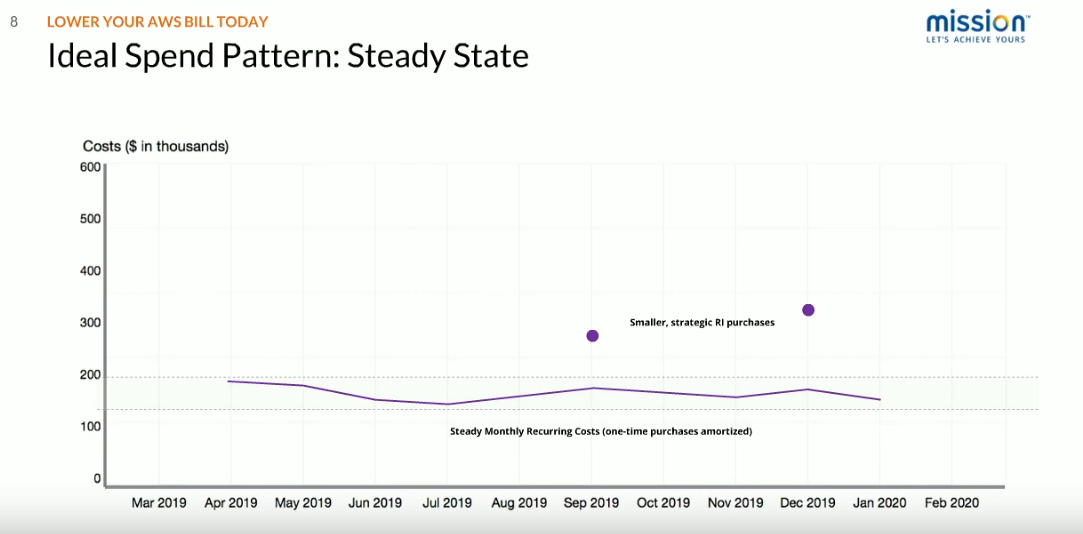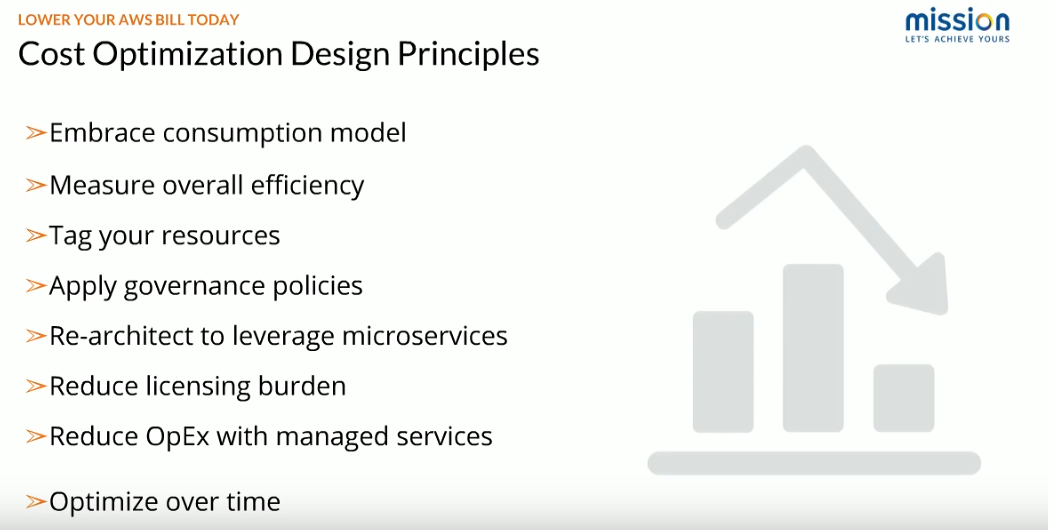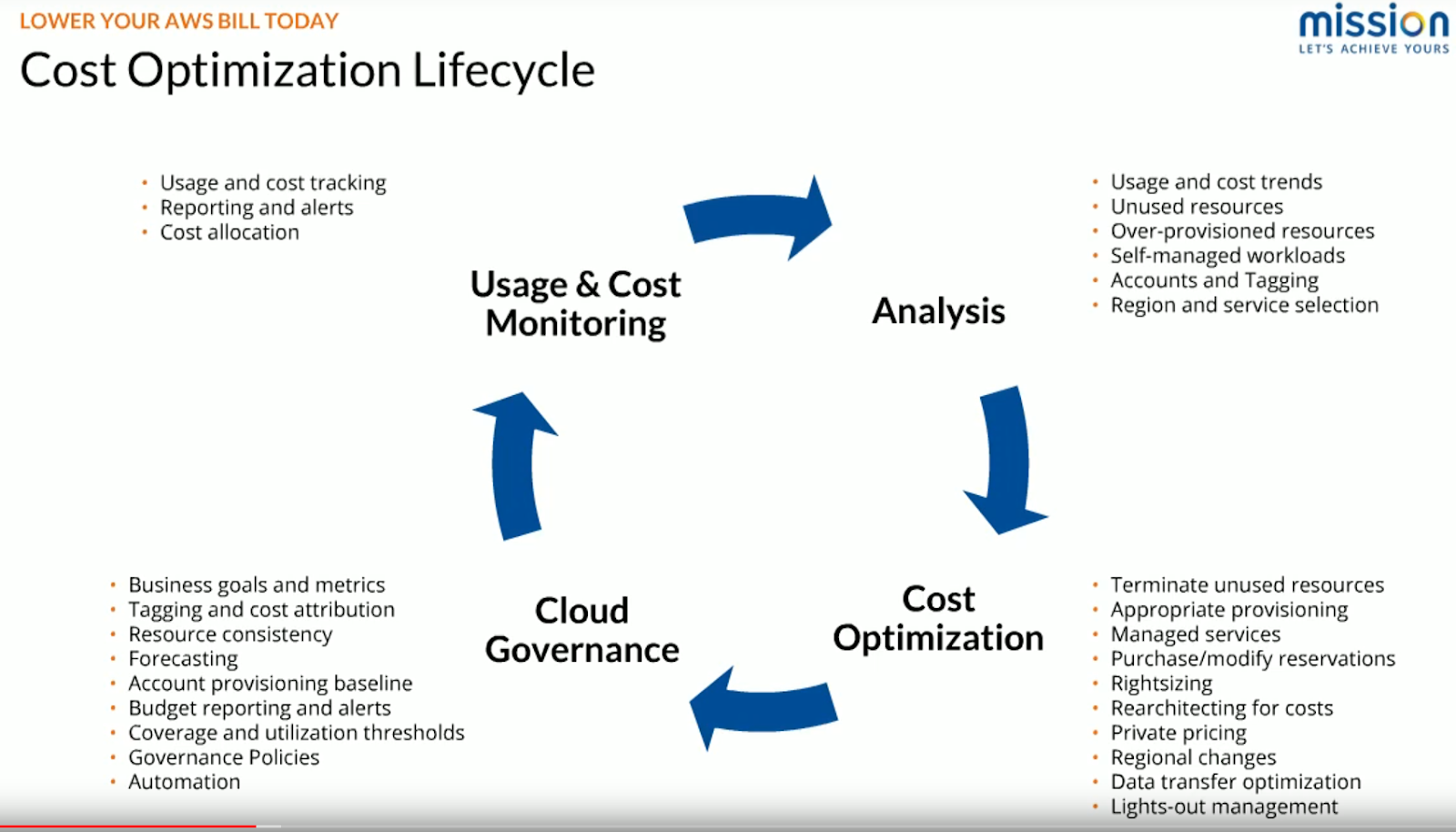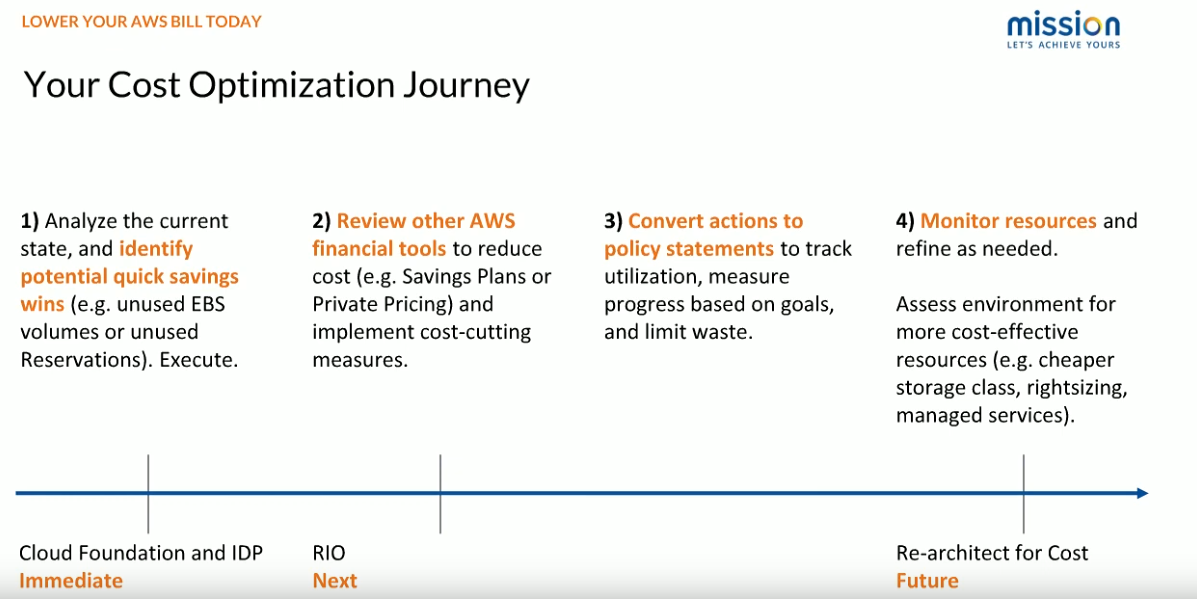Blog
AWS Cost Optimization Strategies
Lower Your AWS Bill Today
There are a lot of challenges when it comes to cost optimization in the cloud, and it’s really more of a journey than a destination. In this post, we’ll discuss the best practices and tools that you need to implement to really have a strong cost management practice. We also dive into a powerful tool called CloudHealth that you can use to drive optimization, and how Mission uses that tool to help our customers.
Cloud Cost Challenges
To discuss the broad concepts of cost optimization in AWS, it’s good to illustrate the challenge by looking at a typical spend pattern for organizations in the cloud. The cloud has a lot of benefits as we all know. It’s a full self-service, on-demand model, consumption-based platform with unprecedented power, and agility. But for many businesses, as they dive in and start deploying workloads, they don’t really have any sort of cost containment or governance strategy in place.
Ultimately, not leveraging programmatic strategic cost management techniques can lead to a continuous climb of costs. From a cost and reporting standpoint, users are going to continue to provision new resources. They’re going to fail to right-size or to shut them down, and they’re not going to take advantage of all the financial instruments that are available to keep the cost in control.
Many people go through this pattern, and they realize they’re spending more than was originally planned, and they turn to reactive, band-aid actions such as doing major reactive one-time reserved instance purchases.

As the curve above shows, it does make an impact, but it’s short-lived because it’s not a programmatic or strategic kind of process.
Let’s instead look at what a spend pattern for an organization that has really a strong practice looks like.

This is a more ideal spend pattern, and what we’re actually looking at is the track of a Mission customer that we’ve been working with for a while. They’ve engaged us to drive this programmatic cost optimization in a continuous way, and you can see the outcome. It’s much more steady-state and predictable. In environments like theirs, that are mature and still growing, albeit gradually, you want to see a steady recurring monthly cost, including any amortized kind of one-time purchases each month.
To get to this point, we have applied a whole series of cost optimization techniques. It’s not just one thing, and we’re providing cost containment and continuous monitoring and actions to keep the costs in check. That includes using cloud-native monitoring tools to increase visibility, taking advantage of cost-cutting techniques with lifecycle policies, right-sizing of instances and purchasing options, and a whole bunch more. One such technique that you’ll see here is rather than doing these large reactive RI purchases, we’re constantly evaluating opportunities to do smaller strategic RI purchases and right-sizing. That can actually end up being more impactful over time.
Cost Optimization Design Principles
It’s also important to talk about some cost optimization design principles.

The first design principle is to embrace the consumption model that the cloud buys. AWS gives you the ability to scale resources up and down based on demand, and you only pay for what you use. To really take advantage of this model, you don’t want to just believe idle resources running 24/7. There’s a lot of other ways you can embrace that consumption model to be sure that you’re optimizing for your cost. It’s a really good principle to have.
Next up is to measure the overall efficiency and to tag your resources. This is all about getting visibility and getting a handle on what is going on in your environment. What’s running? Which resources are deployed? Why are they running? Visibility is one of the most critical factors in creating an effective cost management practice.
We should also touch upon governance. The on-demand nature and the self-service nature of the cloud lends itself to what we call “cloud sprawl,”and having governance policies in place ensures you don’t have a sprawling cloud footprint. Instead, you have a thoughtful and strategic way to grow as your business needs change.
The Cost Optimization Journey
As we’ve mentioned before, cost optimization is a journey, not a destination. To understand cost optimization from a holistic perspective, we like to think of it as a lifecycle.
Here are four general phases of the lifecycle: analysis, cost optimization, cloud governance, and usage and cost monitoring.

In addition to those four phases, you’ll see twenty-eight distinct activities across these phases that make up a complete cost optimization practice, such as tracking usage and costs, right-sizing, taking advantage of private pricing programs, cost allocation, and the implementation of lifestyle policies. Every customer environment and where they are in their journey is a bit different. We recommend not approaching cloud optimization like a one-time project, but rather, a regular, ongoing process of refinement and improvement.
For example, if you are currently in sort of a phase of analysis and moving into cost optimization, it’s important that you don’t stop there, but you continue on to think about how you can apply governance policies.
You might feel overwhelmed by all this. There is a lot to consider, but the good news is that there are tools, services, and systems that can really help you get there faster, and you don’t have to do it all on your own, and you don’t have to do it all in one shot. There are incremental steps and optimization paths you can take to get there. You can kind of walk down to get from zero-to-hero when it comes to optimization.
So far we’ve really talked about the people and process side of things. That’s very important, but it’s also important to consider tools.
Mission is actually partnered with a company called CloudHealth, and they are the creators of a leading Cost Manager Platform or CMP in the market.
The great thing about CloudHealth is that it connects to your AWS account, and it provides management, recommendation, and optimization capabilities, and it does that with in-depth, customizable reporting and alerting. Once deployed and configured in your environment, it can create visibility to help you get a handle on costs, as well as actionable next steps. Mission is a customer of CloudHealth as well, so we actually use it ourselves to drive cost optimization in our customer environments, and we really love it.
How Mission Can Help
CloudHealth can really drive a lot of savings and optimization. With that said, it does require that you have people on your team who have a deep understanding of how to use that platform to really drive those improvements. And you need processes in place that will then maintain and continue to apply those optimizations over time. Mission is here to support you and help you on this journey. Here a couple of programs we offer that may be a good fit.
Cloud Foundation
Let’s start with the most lightweight way to get started. This is Mission’s Cloud Foundation. Cloud Foundation is a service that provides cost optimization, best-practice alignment, and governance to help you become more cost-efficient.
This service includes regular cadence calls with a Mission cloud analyst who will configure CloudHealth, and Mission default reports and automation that can really drive that cost management that’s practice monitoring and granular reporting.
Instant Discount Program
We recently launched a new program, called the Mission Instant Discount Program or IDP. This program is designed to save instant savings okay up to 5% off your AWS bill immediately for 12 months. There’s no no long-term commitment required, and for most customers, there are significant additional savings well above 5%.
The nice thing about IDP is that it gives you guaranteed savings immediately, and there are also opportunities to drive more savings over time. I’ll give you an example. We recently onboarded a customer into Cloud Foundation and the IDP program and within a week we were able to identify another 15% reduction of their bill. It’s a pretty incredible way to get started, and when you enroll in IDP you automatically get all the benefits of Cloud Foundation. It builds on top of Cloud Foundation and that resell program, and that allows you to also get these predictable savings without any commitment.
Your Cost Optimization Journey

Here at Mission, we believe that the cost optimization journey is comprised of four stages. During the first stage, we encourage using the tools you have available to gain a deeper understanding of what you are spending. Once you do this, you can start identifying low-hanging fruit for quick saving. Things like unused EBS volumes or unused reservations and zombie instances, etc. This is a really good place to get started.
Next, at stage 2, you can start to explore the financial tools. The RI’s and savings plans to further reduce your costs where it makes sense. We don’t recommend doing these mega purchases in reactive mode. Try to be strategic and focus on well-known steady-state workloads that are running on newer AWS instance types. If you have legacy instance types which you plan to change later, focus on compute savings plans rather than RI’s.
Lastly, it’s important that you measure the performance of these changes because you don’t want to fall back into the continuous climb. To do this you can leverage more tools and processes, leverage cloud watch for example, and again think about native tools like CloudHealth that can provide strong policy engines for better governance. Once you have that governance and visibility in place, you’re going to want to monitor and refine it as needed and start having conversations internally that are design-related and strategic for your business.
Contact Mission to learn more about how we can help optimize your costs in the AWS cloud.
Author Spotlight:
Jonathan LaCour
Keep Up To Date With AWS News
Stay up to date with the latest AWS services, latest architecture, cloud-native solutions and more.

